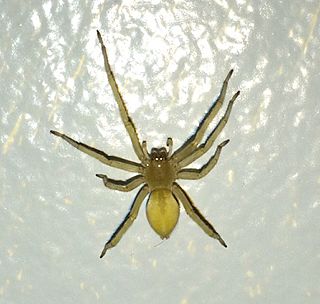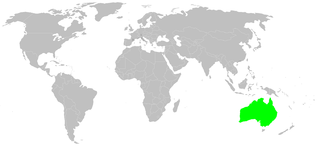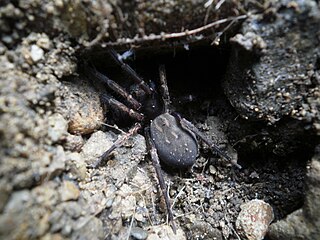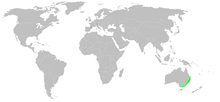
Wolf spiders are members of the family Lycosidae, from the Ancient Greek word "λύκος" meaning "wolf". They are robust and agile hunters with excellent eyesight. They live mostly in solitude and hunt alone, and do not spin webs. Some are opportunistic hunters pouncing upon prey as they find it or even chasing it over short distances. Some wait for passing prey in or near the mouth of a burrow.

Cheiracanthium inclusum, alternately known as the black-footed yellow sac spider or the American yellow sac spider, was formerly classified as a true sac spider, and then placed in the family Miturgidae, but now belongs to family Cheiracanthiidae. It is a rather small pale yellow species that is indigenous to the Americas and can be found living in the foliage of forests and gardens but also can inhabit human homes. Despite common beliefs of necrosis, Cheiracanthium bites cause only localized swelling. C. inclusum is closely related to Cheiracanthium mildei, an introduced species native to Europe which is similar in appearance and natural history and can also be found in North American homes.

Huntsman spiders, members of the family Sparassidae, are known by this name because of their speed and mode of hunting. They are also called giant crab spiders because of their size and appearance. Larger species sometimes are referred to as wood spiders, because of their preference for woody places. In southern Africa the genus Palystes are known as rain spiders or lizard-eating spiders. Commonly they are confused with baboon spiders from the Mygalomorphae infraorder, which are not closely related.

Nursery web spiders (Pisauridae) is a family of araneomorph spiders first described by Eugène Simon in 1890. They resemble wolf spiders (Lycosidae) except for several key differences. Wolf spiders have two very prominent eyes in addition to the other six, while a nursery web spider's eyes are all about the same size. Additionally, female nursery web spiders carry their egg sacs with their jaws and pedipalps instead of attaching them to their spinnerets as wolf spiders do. When the eggs are about to hatch, a female spider builds a nursery "tent", places her egg sac inside, and stands guard outside, hence the family's common name. Like the wolf spiders, however, the nursery web spiders are roaming hunters that don't use webs for catching prey. They have a wide variety of prey, and larger species may prey upon vertebrates, particularly amphibians and fish.

Pirate spiders, members of the family Mimetidae, are araneomorph spiders which typically feed on other spiders.

Austracantha is a genus of spider with a single species, Austracantha minax, commonly known as the jewel spider or the Christmas spider. It is a member of the family Araneidae and is endemic to Australia. They are relatively small spiders, reaching a maximum total body length of only around 12 mm (0.47 in) for females, and 5 mm (0.20 in) for males. Their abdomen has six distinctive projections ("spines") that makes them easy to identify. They are predominantly a shiny black, with variable white, yellow, and orange patterns. Melanistic forms also occur during autumn. They are facultatively gregarious, and can be found in large aggregations of overlapping orb webs. They feed on small flying insects that get entangled in their webs. They are harmless to humans, though the webs can be a nuisance for bushwalkers. They are most abundant during the summer months.

The spider species Tegenaria domestica, commonly known as the barn funnel weaver in North America and the domestic house spider in Europe, is a member of the funnel-web family Agelenidae and a close relative of the hobo spider.

Nephila is a genus of araneomorph spiders noted for the impressive webs they weave. Nephila consists of numerous species found in warmer regions around the world. They are commonly called golden silk orb-weavers, golden orb-weavers, giant wood spiders, or banana spiders.

Argiope keyserlingi is a species of orb-web spider found on the east coast of Australia, from central New South Wales to northern Queensland. It is very similar in appearance to a closely related North-Queensland species, Argiope aetherea. A. keyserlingi is commonly found in large populations in suburban parks and gardens, particularly among the leaves of the Lomandra longifolia. Like many species of orb-web spider, A. keyserlingi shows considerable sexual size dimorphism, as the females are many times larger than the males. Mature females can be seen during the summer months and it is not uncommon to see multiple males on the web of one female.

Steatoda grossa, commonly known as the cupboard spider, the dark comb-footed spider, the brown house spider, or the false widow, is a common species of spider in the genus Steatoda.

The black house spider or common black spider is a common species of cribellate Australian spider, introduced to New Zealand and Japan. A closely related species, Badumna longinqua, the grey house spider, has a similar distribution, but has also been introduced to the Americas.

Zygiella x-notata, sometimes known as the missing sector orb weaver or the silver-sided sector spider, is a spider species in the family Araneidae. They are solitary spiders, residing in daily-spun orb webs. Z. x-notata is a member of the genus Zygiella, the orb-weaving spiders. The adult female is easily recognized by the characteristic leaf-like mark on her posterior opisthosoma, caudal to the yellow-brown cephalothorax.

Deinopis, also known as net-casting spiders, gladiator spiders and ogre-faced spiders, is a genus of net-casting spiders that was first described by W. S. MacLeay in 1839. Its distribution is widely tropical and subtropical. They catch their prey using a specially spun "net". The name is derived from the Greek δεινός (deinos), meaning "fearful", and opis, meaning "appearance", referring to their ogre-like faces. The spelling "Dinopis" is also found, but is regarded as an "unjustified emendation".

Phryganoporus candidus, also known as the foliage web spider, is a small, subsocial jumping spider endemic to Australia. On average, they are 6–10 mm long and are a mottled brown color, covered in silvery grey hair. They typically reside in arid and semi-arid locations, building their nests in various trees, bushes, and other plant-life. They have a mutualistic relationship with Acacia ligulata, and therefore prefer to build their nests in these trees.

Nephila pilipes is a species of golden orb-web spider. It resides all over countries in East and Southeast Asia as well as Oceania. It is commonly found in primary and secondary forests and gardens. Females are large and grow to a body size of 30–50 mm, with males growing to 5–6 mm. It is the second largest of the orb-weaving spiders apart from the recently discovered Nephila komaci. The first, second, and fourth pairs of legs of juvenile females have dense hairy brushes, but these brushes disappear as the spider matures.

Dolomedes minor is a spider in the family Pisauridae that is indigenous to New Zealand, where it is known as the nursery web spider.

Sidymella rubrosignata is a species of crab spiders found in Australia. It is a common spider, often seen on Dianella plants.

Uliodon is a genus of spiders endemic to New Zealand and possibly Australia. They are commonly referred to as vagrant spiders. Vagrant spiders vary in colour from dark brown to almost black, they typically have a body length of 20mm and a 50mm leg span. When alive, the interior of the male’s pedipalp are brightly coloured.

Palystes is a genus of huntsman spiders, commonly called rain spiders or lizard-eating spiders, occurring in Africa, India, Australia, and the Pacific. The most common and widespread species is P. superciliosus, found in South Africa, home to 12 species in the genus. The name Palystes is derived from either the Latin palaestes or the Greek palaistes, meaning "wrestler". The genus was first described by Ludwig Carl Christian Koch in 1875.

Argiope radon is a species of orb web spider native to Australia. It is found in tropical areas of the Northern Territory, Western Australia and Queensland. It is commonly known as the Northern St Andrew's cross spider.





















